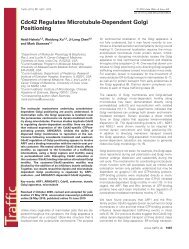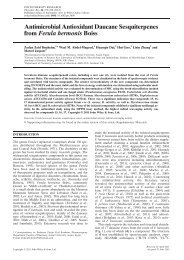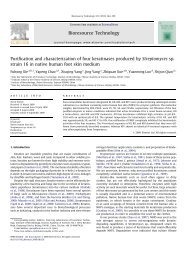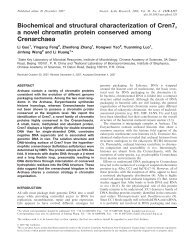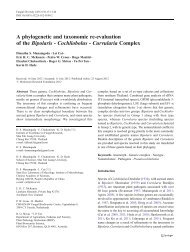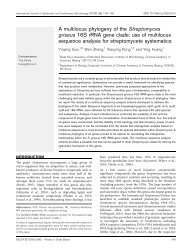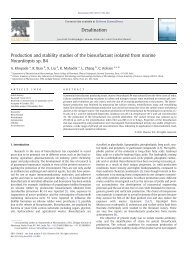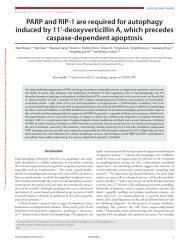Expression of cefF signiWcantly decreased deacetoxycephalosporin ...
Expression of cefF signiWcantly decreased deacetoxycephalosporin ...
Expression of cefF signiWcantly decreased deacetoxycephalosporin ...
Create successful ePaper yourself
Turn your PDF publications into a flip-book with our unique Google optimized e-Paper software.
J Ind Microbiol Biotechnol<br />
Results<br />
<strong>Expression</strong> <strong>of</strong> <strong>cefF</strong> in A. chrysogenum<br />
To express the <strong>cefF</strong> in A. chrysogenum, the plasmid pAg1-<br />
H3-<strong>cefF</strong> was constructed. pAg1-H3-<strong>cefF</strong> carried a hygromycin<br />
B-resistant cassette (hph), kanamycin resistance<br />
gene (kanR), T-DNA region, and the gene <strong>cefF</strong> under the<br />
promoter <strong>of</strong> pcbC (Fig. 1).<br />
The plasmid pAg1-H3-<strong>cefF</strong> was introduced into<br />
A. chrysogenum through A. tumefaciens-mediated transformation.<br />
The hygromycin B resistance transformants were<br />
selected and conWrmed by PCR. These transformants did<br />
not show diVerence in growth and morphological diVerentiation<br />
compared to the wild-type strain (data not shown).<br />
For fermentation, one transformant was selected randomly<br />
and it was designated as B6. Absolute quantiWcation <strong>of</strong> <strong>cefF</strong><br />
conWrmed that only one copy had been inserted in the chromosome<br />
<strong>of</strong> B6 (Table 1). RT-PCR result showed that <strong>cefF</strong><br />
was transcribed normally in B6, and no signal was<br />
observed in the wild-type strain (Fig. 2). However, the CPC<br />
production <strong>of</strong> B6 did not show a signiWcant diVerence compared<br />
to that <strong>of</strong> the wild-type strain through bioassay<br />
against M. luteus (Fig. 3).<br />
Analysis <strong>of</strong> DAOC/CPC in the fermentation broth<br />
The fermentation broth was further analyzed by LC–MS.<br />
Due to impurity <strong>of</strong> the standard sample, DAOC, DAC, and<br />
CPC could be detected by comparing the corresponding<br />
molecular weight. The HPLC method applied here could<br />
separate the DAOC and CPC within an appropriate retention<br />
time. The retention time <strong>of</strong> DAOC was approximately<br />
9.5 min, while the retention time <strong>of</strong> CPC was 10.2 min<br />
(Fig. 4). The DAOC, DAC, and CPC in each sample were<br />
analyzed, respectively, by a high-resolution MS monitor.<br />
The area <strong>of</strong> response signal peak was calculated by the Agilent<br />
LC–MS s<strong>of</strong>tware. The resulting value had been processed<br />
with statistical analysis (Table 2). According to the<br />
peak area, the average ratios <strong>of</strong> DAOC/CPC and DAOC/<br />
DAC in the fermentation broth <strong>of</strong> the wild-type strain were<br />
14.24 and 7.84, while their average ratios were dramatically<br />
<strong>decreased</strong> to 1.34 and 0.49 in B6 fermentation broth<br />
(Table 2). The result also showed that the average ratio <strong>of</strong><br />
DAC/CPC increased in B6 fermentation broth comapared<br />
to that <strong>of</strong> the wild-type strain broth, but not <strong>signiWcantly</strong>. It<br />
is possible that DAC could be converted into CPC<br />
eYciently in this strain and keep the dynamic balance<br />
between DAC and CPC. The amount <strong>of</strong> DAOC in the fermentation<br />
broth <strong>of</strong> B6 <strong>decreased</strong> more than tenfold comapared<br />
to that <strong>of</strong> the wild-type strain. This suggested that<br />
expression <strong>of</strong> <strong>cefF</strong> could <strong>signiWcantly</strong> reduce the content <strong>of</strong><br />
DAOC in the CPC fermentation broth <strong>of</strong> A. chrysogenum.<br />
Discussion<br />
For 50 years, intensive strain improvement has resulted in a<br />
<strong>signiWcantly</strong> higher titer <strong>of</strong> the CPC production in A. chrysogenum<br />
through traditional mutagenesis and genetic engineering.<br />
For example, it has been proven that introducing<br />
cefEF and cefG, which was identiWed as a coding gene <strong>of</strong><br />
rate-limiting DAC-acetyltransferase, increased the yield <strong>of</strong><br />
CPC by 40% [23, 29]. <strong>Expression</strong> <strong>of</strong> cefG under the heterologous<br />
gdh or gpd promoter increased the CPC titer up to<br />
two or threefold [14]. Besides ampliWcation <strong>of</strong> the key biosynthetic<br />
enzymes, improvement <strong>of</strong> corresponding enzymatic<br />
activity <strong>of</strong> precursor synthesis and oxygen supply<br />
also stimulated CPC production [9, 21]. However, none <strong>of</strong><br />
these methods have gained as much achievement as multiple<br />
rounds <strong>of</strong> mutagenesis and screening. Modifying the<br />
industrial strain by enhancing the purity <strong>of</strong> CPC production<br />
will be more practical to the modern pharmaceutical industry.<br />
In the application reported here, adding a single copy <strong>of</strong><br />
<strong>cefF</strong> could <strong>signiWcantly</strong> reduce the ratio <strong>of</strong> DAOC/CPC.<br />
We suggest that this byproduct (DAOC) could be reduced<br />
further by switching other promoters or introducing extra<br />
copies.<br />
As there is a lack <strong>of</strong> available genetic tools, molecular<br />
engineering in A. chrysogenum is still very limited so far.<br />
Since the demonstration <strong>of</strong> successful T-DNA transfer into<br />
Saccharomyces cerevisiae by A. tumefaciens, ATMT has<br />
been successfully applied to transform a diverse array <strong>of</strong><br />
fungi [4, 5, 8, 18]. This technique exhibits many advantages<br />
for the genetic analysis <strong>of</strong> fungi. Our study showed that<br />
A. tumefaciens-mediated transformation was an eYcient<br />
method for the introduction <strong>of</strong> heterologous genes into<br />
A. chrysogenum. With the high transformation eYciency<br />
resulting in one transformant per 1 £ 10 4 spores, more than<br />
30 transformants were collected once in this work, and the<br />
genetic screen marker remained stable after Wve generations.<br />
The high-yielding industrial strains <strong>of</strong> A. chrysogenum<br />
were obtained via constant mutagenesis, and a variety <strong>of</strong><br />
genetic changes occurred and accumulated in these strains,<br />
therefore the industrial strains are diVerent from their parents.<br />
In contrast to the penicillin-producing strain Penicillium<br />
chrysogenum, either the wild-type strain or the<br />
industrial strains <strong>of</strong> A. chrysogenum contain only one copy<br />
<strong>of</strong> the CPC biosynthetic gene cluster [26]. Though the<br />
strain <strong>of</strong> A. chrysogenum examined in this study is the wildtype<br />
strain and produced less CPC in the assay <strong>of</strong> Xask fermentation<br />
than the industrial strains that had been reported<br />
in other references [6, 21, 27], they all produce CPC<br />
through the same biosynthetic pathway. We suggest that<br />
this method could also be applied in the industrial strain. As<br />
presented, the transformant in this work showed a tenfold<br />
decline <strong>of</strong> the accumulation <strong>of</strong> DAOC. This application<br />
should help to decrease the cost <strong>of</strong> CPC production.<br />
123





